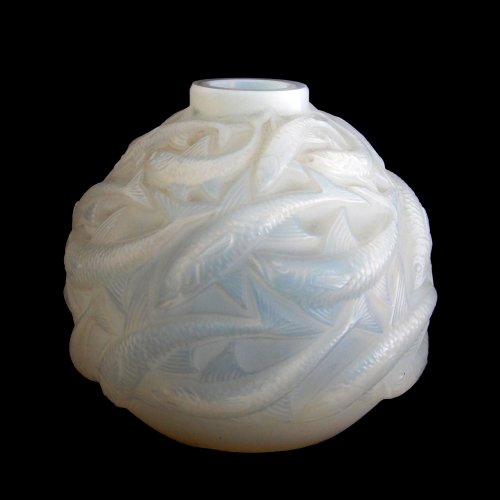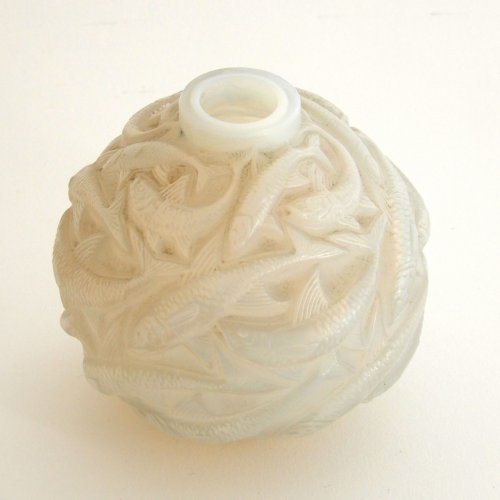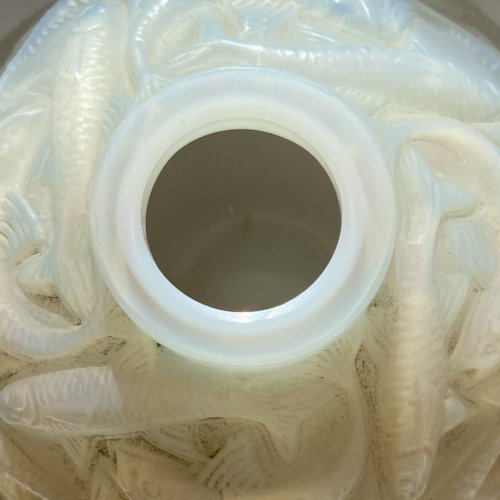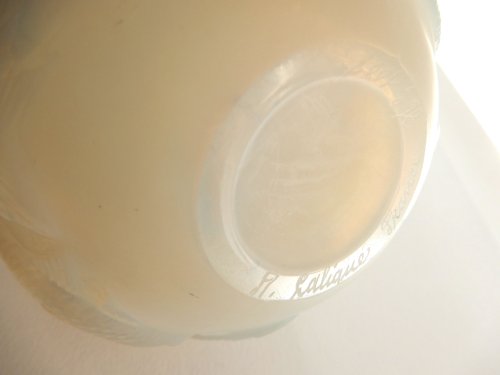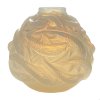René Lalique (1860-1945) Small vase 'Oléron' or 'Petits poissons'
About this piece
Spherical vase with numerous small fish, the vase is called 'Oléron' but is also called 'Petits poissons'.
The vase is extremely refined and beautifully made, it is executed in opalescent glass. The glass consists of multiple layers of opalescent and transparent glass on top of each other, this can be clearly seen at the neck, like the rings of a tree, you see a kind of rings that differ in colour intensity, those are the different layers of glass, (cased opalescent glass), it is a difficult technique. The vase still has very light traces of a patina, so it has had a patina. Through use and especially through cleaning the vase, the infamous annual scrub, the patina has been lost almost completely. In itself, this is not a problem at all because it was an addition to the design. Lalique originally made and sold the vase with and without patina. It just depended on the preference of the buyer. To achieve opalescent glass, a special alloy is needed, everyone had their own secret recipe. René Lalique used, in addition to the usual ingredients such as silicon dioxide or sodium, arsenic, which was banned after the war, and real gold, to increase the colour intensity. Opalescent glass has the special property that it appears bluish/white when backlit, and when light shines on the vase, the glass gets an intense golden glow, as if the sun is shining on it. Very beautiful. The first photo was taken while the vase was placed in front of the window with the sun shining outside. The rather distracting background has been removed, but nothing has been done or altered to the vase itself.
The vase is blown into the mould. It is a design by René Lalique from 1927 and has model number 1008. It was listed in the catalogue of 1928 and 1932.
The vase is signed on the underside with: 'R. Lalique, France, No. 1008'. This signature is applied with the wheel (molette). This way of signing, with the addition 'France' and the model number, was only used between 1928-1932. After 1932, the model number was omitted. According to literature, this was also only done with objects that were blown into the mould, very occasionally an object was still signed in this way if the pressed signature was not clear.
At some point, in the early 1930s, René Lalique, partly due to the crisis, decided to no longer produce designs with labour-intensive finishes. This vase was also part of that decision, and it is therefore no longer mentioned in the 1937 catalogue.
The Gemeentemuseum Den Haag (Municipal Museum of The Hague) also has an opal Oléron vase in its collection.
Biography:
René Lalique (1860-1945) was active as an
apprentice jeweller at age 16. After been 2 years in England as an
apprentice, he started his own business ,in 1880, as a jewellery
designer. He soon became a success, especially after he participated at
the Universal Exhibition of 1900 in Paris. Thereafter his name was
definitively established.
From 1890 he was also very interested in glass. He adapted glass in his designs. He soon expanded his work with the proper tools and equipment, and also increased his knowledge, especially in the field of colouring and moulds. In 1905 he received orders from François Coty to design various perfume bottles, he experimented with new styles and techniques. During that time he started to work with moulds and pressed glass. In 1912 he started his second career as a master glass artist. He once said that he would create something so special that's not been seen before. Which he certainly succeeded.
He then made except small glass objects such as jewellery and perfume bottles, major works as vases, lamps, tableware, clocks, car mascots, but also architectural glass applications such as door handles, wall panels etc.
After WWI, the French government offered him for not much money a factory in the Alsace, the Alsace was French again. He built a new glass factory in Wingen-sur-Moder where he produced most of his pressed glass vases. Mid 1930's he closed his factory in Paris and everything was produced in Wingen-sur-Moder, till now. After his death in 1945, his family continued the company.
He is seen as one of the largest glass artists in the world. His
work is admired worldwide in museums, there are also several museums
that are only dedicated to René Lalique, such as Lalique Museum Doesburg
in the Netherlands and of course Musée Lalique in Wingen-sur-Moder,
France, but also in Hakone (Japan) and many others.
Literature:
- Félix Marcilhac, ‘R. Lalique,
Catalogue raisonné de l’oeuvre de verre’, Les Éditions de l’Amateur,
Paris 2011, p. 440.
- Christopher Vane Percy; 'The glass of Lalique, a
collectors guide', Studio Vista, Cassell & Collier Macmillan
Publishers Ltd, London, 1977, p.148.
- Philippe Olland; 'Dictionnaire
des Maîtres Verriers de l'Art Nouveau á l'Art Déco, Marques &
signatures'. Éditions Faton 2016. P. 192-199.
- Victor Arwas, 'Glass, Art Nouveau to Art Deco'. Academy Editions
London 1987. P. 179-193.
- Lennart Booij; 'Lalique in Nederland' Gemeentemuseum Den Haag, Waanders Uitgevers, Zwolle, 2013. P.163, 165 (Image) en 209.
Condition
Excellent
Material:
Glass
Measurements:
Height: 9 cm
(3,54")
Period:
1928-1932
Origin:
France
Artist / atelier:
René Lalique,

